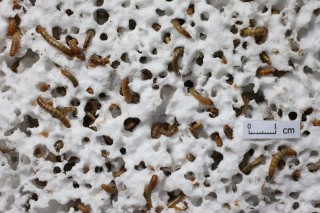 EPS, or expanded polystyrene, is the plastic foam commonly found in food containers and has been a source of controversy due to the unrecyclable waste its use creates. Now researchers may have found an unlikely solution: Mealworms. The larvae of the darkling beetle will not only feed on EPS, but the microorganisms in their gut biodegrade the material, later expelling a seemingly harmless product that may be useful as soil for crops. The plastic doesn’t seem to be toxic to the bugs either. The research is still in its early stages, but many are excited by the possible implications for EPS recycling.
EPS, or expanded polystyrene, is the plastic foam commonly found in food containers and has been a source of controversy due to the unrecyclable waste its use creates. Now researchers may have found an unlikely solution: Mealworms. The larvae of the darkling beetle will not only feed on EPS, but the microorganisms in their gut biodegrade the material, later expelling a seemingly harmless product that may be useful as soil for crops. The plastic doesn’t seem to be toxic to the bugs either. The research is still in its early stages, but many are excited by the possible implications for EPS recycling.
For more information, see Plastics News.
